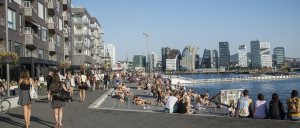The Sustainable Urban Future of Nordic Cities
By IBI Insights
Date
December 1, 2017In a Nordic context, contemporary cities are characterized by their commitment to accessible greenery and water, health, wellbeing and the environment. This has been reflected in a strong urban focus on resilience, compact development, sustainable mobility, and a low carbon economy. The sustainability success stories achieved in the Nordic countries arise at least partially out of their regional context, but this does not limit their relevance or prevent their application to other cities beyond the Nordic region. This article explores examples of such stories.
Growth Without Emissions
There is a long tradition of environmental awareness and protection in the Nordic countries. More than a century ago, this was demonstrated through efforts to preserve green and blue space for urban workers and their families. Fast-forward to 1972, and this focus was illustrated when Stockholm hosted the UN Conference on the Human Environment, the first UN conference on environmental protection. More recently, this emphasis and leadership on environmental issues has manifested itself through a host of actions that have seen GHG emissions decline even as Nordic economies have grown, and strategies that emphasize the interaction between climate change mitigation and adaptation, which are typically addressed separately.
Preparing Cities for Climate Change
By integrating mitigation and adaptation policy, Nordic cities aim to strengthen their resilience to climate change events. For these cities, there is particular concern regarding the impacts of water-related issues such as increased precipitation, sea level rise and urban flooding, all of which are projected in this region by the IPCC. Nordic cities have translated this concern into an opportunity to renew and reinforce their commitment to high-quality green and blue spaces. In practice, this has motivated Stockholm to make a 1.4+Bn USD investment in its central locks system, which control the flow of water between the Baltic Sea and Lake Mälaren, the region’s primary source of drinking water. It has also led the city to adopt a new storm-water strategy that prepares for a 30% increase in precipitation by 2100 and to improve the quality of storm-water to reach the city’s environmental quality standards. Zooming in, efforts to achieve greater resilience through the improvement of blue and green space are evident in an innovative new public space in Copenhagen. Designed as a multifunctional space that can handle rising volumes of rain, Tåsinge Plads is a square that shows that rainwater can inspire new recreational spaces. Likewise, the winning project from the Nordic Built Cities Challenge in 2017, the Soul of Norrebro, addressed rainstorm flooding while simultaneously addressing local social community development. From megaprojects to fine-grain public spaces, Nordic cities are supporting resilience and preparing for climate change in a diversity of way. Cities worldwide face similar challenges, and whether they seek billion-dollar solutions or small-scale improvements, the Nordic context offers useful insight.

Sørenga, Oslo. Photo Credit: Katrine Lunke/Wikimedia Commons
Creating Neighbourhoods that Consume Less
Beyond transport, improved building performance offers another key opportunity for climate change mitigation. Nordic cities are addressing this primarily through three approaches: green building at both the building and neighbourhood scale, stringent energy standards on all new buildings, and building retrofits. Efforts to reduce energy consumption in the transportation and building sectors are supported by a long tradition of climate and environmental monitoring in the Nordic Region. Illustrating the triple-helix approach that Nordic cities have used extensively to support environmental innovation, monitoring is often carried out by academic institutions, innovations to improve the results are developed by private actors, and new ambitious standards are implemented by the public sector. Although the performance of new green buildings in the Nordic Region is strong, continued improvements are required in existing structures. Approximately 70% of the estimated building stock for 2050 has already been constructed; including the extensive supply of modernist apartment housing that is prevalent in larger Nordic cities. As such, building retrofits are vital to sustainability improvements. Equally important, many of these buildings are located in disadvantaged and marginalized neighbourhoods. Conducting the retrofits, while ensuring they remain affordable to residents is essential to social sustainability. As in other places, Nordic cities face ongoing challenges in reducing energy use and minimizing climate change impacts.
Conclusion
Sustainability, or the lack thereof, presents many challenges around the world today. However, as illustrated by efforts in Nordic cities, there are solutions. Supporting resilience, compact development, sustainable mobility and a low-carbon economy are key steps towards a sustainable future. But equally, or perhaps even more importantly, efforts to achieve these goals and achieve sustainability can also enhance wellbeing, improve quality of life and strengthen the economy, enabling residents to thrive. By combining Nordic cooperative know-how with strategies, products and ideas that are relevant to specific regions or contexts, there is a tremendous opportunity to unlock new opportunities. In doing so, a healthier, greener and thriving future awaits.
This article has been shortened for publication on TH!NK. To read the full text of this article, visit “Sharing a Sustainable Urban Future: A Nordic Cities Perspective” on Nordregio.
Originally published on Nordregio
Photo by Jason Briscoe on Unsplash







